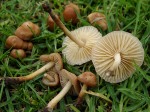 Also known as Scotch bonnet, fairy ring champignon are well known in Europe and North America where they appear in rings, troops, or arcs from late spring to fall in grassy areas such as fields, meadows, pastures, and lawns. There other edible and poisonous mushrooms that also grow in fairy rings so the common name, fairy ring champignon, is misleading. The fairy ring champignon is 1 ½ to 3 ¼ inches tall with a cap ¾ to 2 ½ inches across. The cap is pale leather brown when dry, and tan when wet. It is bell-shaped to conical at first but becomes flat with a large central umbo and undulating margin that is sometimes irregular. The cream to pale leather-brown gills are widely spaced and almost free on the stem. The long slender stem is tough, fibrous, and cream to leather brown. The spores are white.
Also known as Scotch bonnet, fairy ring champignon are well known in Europe and North America where they appear in rings, troops, or arcs from late spring to fall in grassy areas such as fields, meadows, pastures, and lawns. There other edible and poisonous mushrooms that also grow in fairy rings so the common name, fairy ring champignon, is misleading. The fairy ring champignon is 1 ½ to 3 ¼ inches tall with a cap ¾ to 2 ½ inches across. The cap is pale leather brown when dry, and tan when wet. It is bell-shaped to conical at first but becomes flat with a large central umbo and undulating margin that is sometimes irregular. The cream to pale leather-brown gills are widely spaced and almost free on the stem. The long slender stem is tough, fibrous, and cream to leather brown. The spores are white.
With its thick flesh and delightful sweet almond taste, this mushroom is popular with many people. The stem should be discarded and the cap cleaned with a brush if necessary. The mushroom is considered very versatile because it goes with many other foods and so can be used with meats, pasta, and eggs, as well as being added to soups, and stews. Because of its sweetness, it can also be incorporated into to baked goods such as cookies. The caps dry well in a dehydrator but can be strung on a string and hung in a cool airy place. They retain all their flavor and shapewhen re-hydrated either in water or cooking liquid. Alternatively, blanched caps can be preserved in spiced red Vermouth, extra virgin olive oil, wine, or cider vinegar.
Fairy ring champignon has several look alikes and one, the ivory mushroom (Clitocybe dealbata) is poisonous and often found growing with fairy ring champignon. When gathering mushrooms from the wild expert advice on identification should be sought before consuming the.
Photo Credit: By user Lord Mayonnaise. Image Number 112385 at Mushroom Observer. https://commons.wikimedia.org/w/index.php?curid=19740150